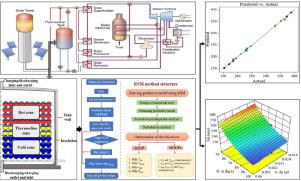Computers & Chemical Engineering ( IF 3.9 ) Pub Date : 2022-07-21 , DOI: 10.1016/j.compchemeng.2022.107930 Karem Elsayed Elfeky , Abubakar Gambo Mohammed , Qiuwang Wang

|
The majority of prior experimental and computational studies of the energy tank system employed in solar power plant systems have been focused on parametric studies. The interaction effects of several input factors on the thermal behavior of the TTES tank configuration using RSM have not yet been addressed. A predictive approach depending on the response surface method (RSM) is built in this work to demonstrate the link between the independent and dependent parameters of the thermocline storage tank structure. The two-phase dispersion-concentric numerical model equations were calculated and solved using MATLAB software. RSM is used for both single and multi-objective optimization to suggest appropriate control parameters for various optimization purposes. Four response factors are considered: charging/discharging time, efficiency, and recovered energy. The analysis of variance check and perturbation assessment is as well used to assess the model's appropriateness and statistical significance. Based on the findings, it is recommended to choose a capsule diameter of 0.015 m, a charging cycle inlet temperature of 400°C, a discharging cycle inlet temperature of 250°C, and a molten salt mass flow rate of 100 kg/s to minimize charging and discharging time while also maximizing overall efficiency and recovered energy.
中文翻译:

基于响应面法的三层温跃层罐性能预测与优化
太阳能发电厂系统中使用的能量罐系统的大多数先前实验和计算研究都集中在参数研究上。几个输入因素对使用 RSM 的 TTES 罐配置的热行为的交互影响尚未得到解决。在这项工作中建立了一种基于响应面法 (RSM) 的预测方法,以证明温跃层储罐结构的独立参数和相关参数之间的联系。采用MATLAB软件计算求解了两相色散同心数值模型方程。RSM 用于单目标和多目标优化,为各种优化目的建议适当的控制参数。考虑四个响应因素:充电/放电时间、效率、并恢复能量。方差检查和扰动评估的分析也用于评估模型的适当性和统计显着性。根据研究结果,建议选择胶囊直径为 0.015 m、充电循环入口温度为 400°C、放电循环入口温度为 250°C、熔盐质量流量为 100 kg/s最大限度地缩短充电和放电时间,同时最大限度地提高整体效率和回收能量。











































 京公网安备 11010802027423号
京公网安备 11010802027423号